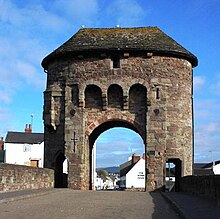Monmouth Town Walls and Defences
| Monmouth town walls and defences | |
|---|---|

Monnow Bridge Gatehouse, part of the Monmouth town walls and defences
|
|
| General information | |
| Location | Monmouth, Monmouthshire, Wales |
| Opened | circa 1300 |
The Monmouth town walls and defences comprise the defensive system of town walls and gates built in Monmouth, Wales between 1297 and the early part of the following century. Wye Bridge Gate, East Gate (Dixton Gate), Monk's Gate, and Monnow Bridge Gate were access points to the town. West Gate, across Monnow Street, also provided access. Only the Monnow Bridge Gatehouse survives intact, albeit in a substantially modified version from the original.
The castle of Monmouth was originally built by the Normans in the late 11th century, as one part of a system of fortifications to help establish their dominance of the Welsh Marches, and as a base for extending their control into Wales itself. The castle, which overlooked the confluence of the rivers Wye and Monnow in a strategically important border area, was initially a modest motte and bailey structure, rebuilt in stone by 1150. A small market town developed around the castle and, in 1267, it passed into the hands of Edmund Crouchback, Earl of Lancaster and son of Henry III. In turn, it passed to his own son Henry de Lancastre. On 27 August 1297, he petitioned his uncle, Edward I, to issue a murage grant for the town. The 1297 grant was issued for five years and the funds collected allowed for the construction of the medieval town walls and gates.
On 1 June 1315, again at Henry de Lancastre's request, the grant was renewed for another three years, indicating that the project was either incomplete or in need of repairs. The murage indicated that the levy was to be on "all wares brought for sale into the town." Town walls were regarded as necessary for several reasons: they provided defensive protection for the Anglo-Normans against the sometimes hostile Welsh inhabitants of the nearby countryside, they protected and allowed the policing of the market, and they allowed the easier collection of taxes and dues. The walls and gates also served as a status symbol. In addition to their defensive use, the town gates were utilised for hundreds of years to collect tolls. These were authorised by the patent rolls of 1297 and 1315.
...
Wikipedia
